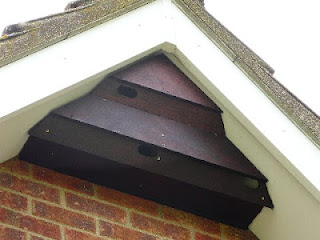 |
| 2 white faces peer out. One could be a chick. |
UPDATE 2020 In subsequent years, up to 7 pairs of Swifts have nested
UPDATE 20th July 2012: We went to St Neots to see progress. From the scaffolding, we found feathers in boxes 11 & 12, a completed nest in 10 and we saw a swift disappear into box 8. A short while later, 2 white faces appeared at the entrance. Yeessss!!
Further, we found four occupied boxes out of the 12 in the church, up from 2 last year.
UPDATE 24th May: Marcus de Figueiredo reports seeing 2, possibly 3 pairs of Swifts using the new nest sites. The netting has been removed and although the scaffold poles are still in the way, the Swifts ignore them.
Written by Dick
We can report good progress in the story of the old Brook Street factory site Swift colony. After a shaky start we have excellent cooperation with Callisto Homes who have made great efforts to achieve a satisfactory solution to the loss of 6 Swift nest sites.
 |
Bill Murrells assessing the space utilised by Swifts
before the roof was removed. Photo Alison Pearson |
First, let's examine where the Swifts nested under the asbestos roof. As is normal, they were nesting on top of the wall under a single layer of asbestos. One can only imagine the temperatures reached in the heat of the mid-day sun, and, not surprisingly, when Bill Murrells examined the nest sites, he found a number of dessicated Swift corpses. This place was far less than ideal for nesting Swifts.
 |
A dessicated Swift which probably died from heat exhaustion
Photo Alison Pearson |
One can only wonder at the success rate of Swifts nesting in such a difficult situation.
It was refreshing that the project manager, Marcus de Figueiredo and the bricklayers on site, quickly got on board with what needed to be done to try to rescue, and improve, this well known Swift colony.
As
previously reported, Bill came up with the great idea of using air brick liners, customised using an angle grinder to turn them into attractive, effective Swift bricks
 |
| Swift bricks in position. Photo Marcus de Figueiredo |
Although the bricklayers were unable to use the total length of the bricks supplied, we have ended up with 12 nest places, roughly 210 x 175mm in floor area, with an entrance 75mm x 28mm. We know that Swifts can breed in spaces smaller than this, so it will be interesting to see the uptake in these new nesting places.
 |
| Photo Marcus de Figueiredo |
It now remains to place a barge board that covers most of the front of the nest-boxes, insulating them from the sun.
There are now 12 quality nesting sites, where before, there were 6 less than ideal nest sites. What started off as a potential disaster for the Swifts of St Neots, over the period of a week, is ending as a triumph for cooperation, for the Swifts, and for the people of St Neots who can continue to enjoy this well known colony.
Postscript:
On 11th May, we (Dick and Bill, with David Gill) were escorted by bricklayer, Lee, to see the finished boxes with the barge board in place.
 |
| Left side entrances partially or wholly behind the barge board |
At first we were dismayed, because, on the left side, some of the entrances were behind the barge board. However, on closer inspection, we found there is a 50mm gap between the barge board and the wall, leaving plenty of space for a swift to crawl up into the entrances.
 |
| Right side entrances clear of barge board |
 |
| Left side entrance |
 |
| Right side entrance |
 |
| Bill Murrells with bricklayer Lee |
The swifts are quite likely to be attracted to this gap, as it is exactly the kind of place they would seek nest sites.
With the barge board in place, the boxes are well sheltered from the sun, so there should be no problems with temperature on this south-facing aspect.







































